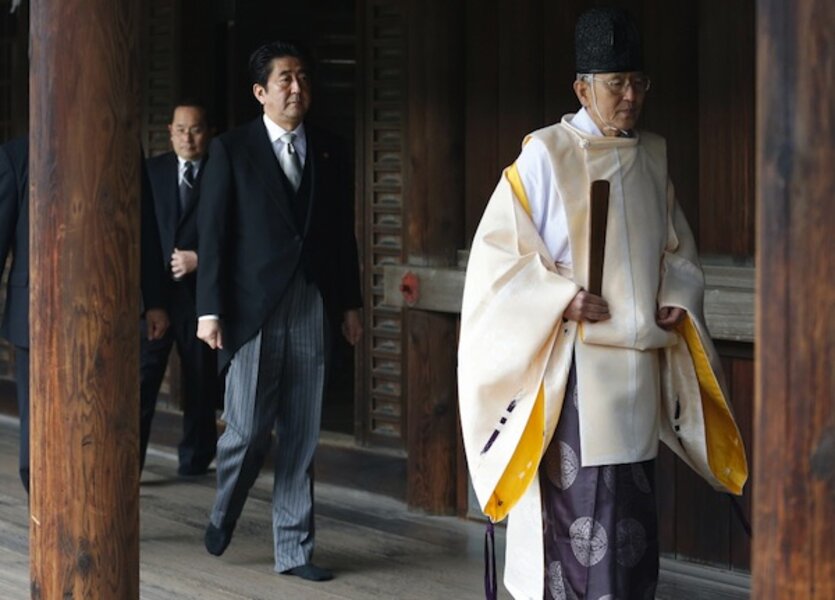Japanese PM visits war shrine, stirring regional tensions
Loading...
| Beijing and Tokyo
Japanese Prime Minister Shinzo Abe spun East Asia deeper into a vortex of mistrust and recrimination Thursday, visiting a controversial shrine honoring Japan’s war dead that its neighbors view as a symbol of Tokyo’s past militarist aggression.
China reacted fiercely, issuing a “strong protest and severe condemnation” of Mr. Abe’s visit to Yasukuni, where the memorials of 2.5 million war dead, including 14 Class A war criminals, are enshrined. A minister in South Korea, which also suffered grievously under Japanese occupation, called the move “deplorable.”
Abe’s visit to Yasukuni, the first in seven years by a sitting prime minister, appeared to kill any hopes of early reconciliation among the three nations, currently locked in territorial disputes and resentment over Japan’s behavior during and before World War II.
“This is one of the worst possible things he could have done,” says Jia Qingguo, a professor of International Studies at Peking University. “Pragmatic management of the problems between China and Japan will become more difficult.”
Abe told reporters after the visit, which marked the first anniversary of his inauguration, that he had intended to “convey my resolve that people never again suffer the horrors of war,” and that “I have no intention to hurt the feelings of the Chinese or Korean people.”
Although “he knew this would cause uproar,” according to one Japanese official familiar with Abe’s thinking, the Japanese leader reasoned that he had little to lose. “Relations with China cannot go further south – they have hit bottom,” the official said. The two nations are locked into a bitter dispute over ownership of a group of rocks known in China as the Diaoyu islands and in Japan as the Senkaku.
Prof. Jia is not persuaded. “This can definitely make the relationship worse,” he warns, “and there are people in China thinking of tougher actions that China can take” in its military standoff around the islands.
The US embassy in Tokyo, in an unusually rapid response, said Washington was “disappointed” by Abe’s action, which it feared would “exacerbate tensions” with Japan’s neighbors. The shrine visit marks another turn of the screw in the region a month after Beijing declared an aerial defense identification zone over the disputed islands, a move Japan angrily rejected.
In October, Secretary of Defense Chuck Hagel and Secretary of State John Kerry, on a visit to Japan, paid tribute at Chidorigafuchi, Japan’s national cemetery, which many believe would be a less incendiary focal point for the country’s war-related commemorations. Hundreds of thousands of unidentified war dead are buried there, mostly in communal plots.
In sending senior politicians to Chidorigafuchi, the US had made clear its disdain for Yasukuni, says Koichi Nakano, a professor of politics at Sophia University in Tokyo.
“It was as if they were saying to Abe that he, too, should go to Chidorigafuchi, not to Yasukuni,” Mr. Nakano said. “The US seems worried about Abe’s nationalist tendencies. There are also anxieties over Abe’s enthusiasm for constitutional reform and a bigger role for the Japanese military.”
Military budget hike
Abe, who oversaw the increase of Japan’s military budget this year and sought to amend its pacifist Constitution, is keen to restore Japan’s pride in its past and is unapologetic about its wartime history.
He visited Yasukuni, suggests Robert Dujarric, a political analyst at Temple University in Tokyo, “because he believes in it. He is a values politician…and Yasukuni symbolizes Japan’s military modernization, defense of its sovereignty and the sacrifice of Japanese soldiers and sailors,” all contemporary political hot-button issues as Japan faces an increasingly assertive China.
“Abe feels it is necessary for a Japanese leader to pay homage to the country’s war dead,” explains Tomohiko Taniguchi, an adviser to the prime minister. “It is all about Japan’s collective memory and his fears that this mythology could become rootless. He probably decided that at some point, a political leader like him should not look at the headlines but follow his convictions.”
Japan’s foreign minister, Fumio Kishida, said he hoped Abe’s visit would not worsen Japan’s ties with its neighbors. "I understand that a politician's visit or a minister's visit to the shrine is a matter of his or her personal beliefs,'' Mr. Kishida told reporters.
Conservative pressure
Abe is unlikely to pay a political price at home, where TV stations broke into scheduled programming to show live coverage of the leader, dressed in formal attire, being driven to Yasukuni, where he stayed for about 15 minutes.
His approval ratings have recovered slightly, having dipped earlier this month in the wake of the introduction of an unpopular state secrets bill. Moreover, his shrine visit will have pleased voters who wanted their leader to demonstrate resolve in the face of Chinese provocations over the disputed islands.
Abe had reportedly come under pressure from his conservative backers in the governing Liberal Democratic Party to make a pilgrimage to Yasukuni by the year’s end, given that another opportunity would not have arisen until the shrine holds a festival next spring.
Abe did not visit the shrine during his first term as prime minister that ended in 2007. He later expressed regret that he – for diplomatic reasons – had not done so. A deep admirer of his grandfather, Nobosuke Kishi, who was Minister of Industry for much of the Second World War, Abe sparked controversy earlier this year when he he said that the meaning of “aggression” had yet to be defined in the context of Japan’s invasion of China and Korea.
Coming in the wake of such statements, Abe’s Yasukuni visit, which has upset Washington and infuriated Beijing and Seoul, “is very self destructive,” says Shen Dingli, an international affairs analyst at Fudan University in Shanghai. “Japan has hurt itself.”







